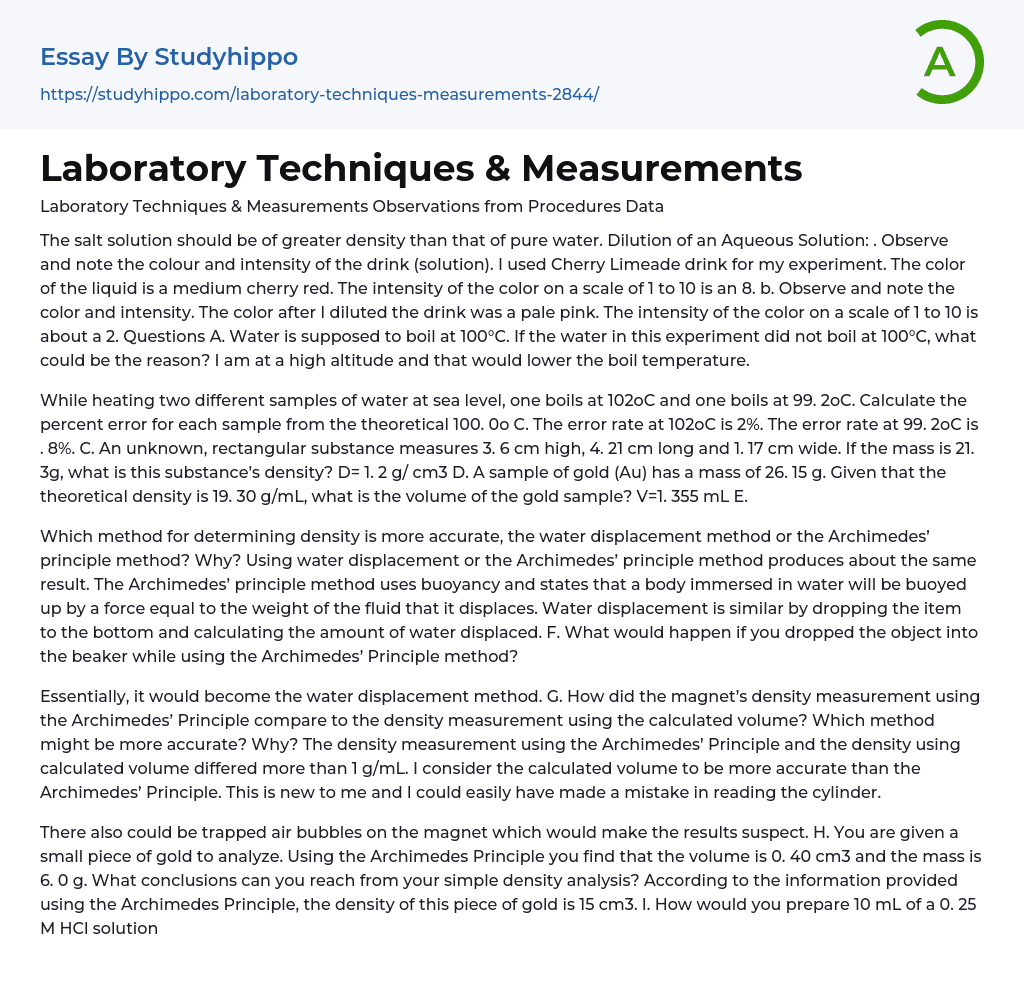

Laboratory Techniques & Measurements: Cherry Limeade Essay Example
The salt solution should be of greater density than that of pure water. Dilution of an Aqueous Solution: . Observe and note the colour and intensity of the drink (solution). I used Cherry Limeade drink for my experiment. The color of the liquid is a medium cherry red. The intensity of the color on a scale of 1 to 10 is an 8. b. Observe and note the color and intensity. The color after I diluted the drink was a pale pink. The intensity of the color on a scale of 1 to 10 is about a 2.
Water is supposed to boil at 100°C. If the water in this experiment did not boil at 100°C, what could be the reason? I am at a high altitude and that would lower the boil temperature. While heating two different samples of
...water at sea level, one boils at 102oC and one boils at 99. 2oC. Calculate the percent error for each sample from the theoretical 100. 0o C. The error rate at 102oC is 2%. The error rate at 99. 2oC is . 8%. C. An unknown, rectangular substance measures 3. 6 cm high, 4. 21 cm long and 1. 17 cm wide. If the mass is 21. 3g, what is this substance’s density? D= 1. 2 g/ cm3 D. A sample of gold (Au) has a mass of 26. 15 g. Given that the theoretical density is 19. 30 g/mL, what is the volume of the gold sample? V=1. 355 mL E.
Which method for determining density is more accurate, the water displacement method or the Archimedes’ principle method? Why? Using water displacement or the Archimedes’ principl
method produces about the same result. The Archimedes’ principle method uses buoyancy and states that a body immersed in water will be buoyed up by a force equal to the weight of the fluid that it displaces. Water displacement is similar by dropping the item to the bottom and calculating the amount of water displaced.
What would happen if you dropped the object into the beaker while using the Archimedes’ Principle method? Essentially, it would become the water displacement method. How did the magnet’s density measurement using the Archimedes’ Principle compare to the density measurement using the calculated volume? Which method might be more accurate? Why? The density measurement using the Archimedes’ Principle and the density using calculated volume differed more than 1 g/mL. I consider the calculated volume to be more accurate than the Archimedes’ Principle. This is new to me and I could easily have made a mistake in reading the cylinder.
There also could be trapped air bubbles on the magnet which would make the results suspect. H. You are given a small piece of gold to analyze. Using the Archimedes Principle you find that the volume is 0. 40 cm3 and the mass is 6. 0 g.
What conclusions can you reach from your simple density analysis? According to the information provided using the Archimedes Principle, the density of this piece of gold is 15 cm3.
How would you prepare 10 mL of a 0. 25 M HCl solution if 1 M HCl was available? How much 1 M HCl is needed? How much distilled water is used? First, the 1 M HCI would need to be diluted. Use 3 (. 75) parts water and
1 part (. 25) 1 M HCI. J. What is the final concentration of the colored drink in the volumetric flask? You would need 2. 5 mL M HCI and 7. 5 mL distilled water to prepare 10 mL of a 0. 25 M HCI solution. K. How does the color in the volumetric flask compare to the original color before diluting? The color in the volumetric flask is very pale and diluted in comparison to the original color. To help you get a feel for metric measurements, you need to know the relative magnitude of a few basic measurements.
For example: 1 mm = thickness of a dime; 2. 5 grams = weight of a penny; 20°C = normal room temperature. L. Determine the following: a. Determine your mass or the mass of a friend, pet, or another large object in kilograms (kg)? Don’t forget to identify the mass you are measuring. Me= 79. 4 kg b. What weighs approximately 1 g? Large Paper clip c. What is approximately 1 cm long, wide or thick? The head of the bolt used in this experiment is 1 cm wide d. What weighs about 100 g? A pair of kitchen shears e. What weighs about 1000 g? 1 36oz. Bottle of ketchup.
- Organic Chemistry essays
- Acid essays
- Calcium essays
- Chemical Bond essays
- Chemical Reaction essays
- Chromatography essays
- Ethanol essays
- Hydrogen essays
- Periodic Table essays
- Titration essays
- Chemical reactions essays
- Osmosis essays
- Carbohydrate essays
- Carbon essays
- Ph essays
- Diffusion essays
- Copper essays
- Salt essays
- Concentration essays
- Sodium essays
- Distillation essays
- Amylase essays
- Magnesium essays
- Acid Rain essays
- Bottled Water essays
- Agriculture essays
- Albert einstein essays
- Animals essays
- Archaeology essays
- Bear essays
- Biology essays
- Birds essays
- Butterfly essays
- Cat essays
- Charles Darwin essays
- Chemistry essays
- Dinosaur essays
- Discovery essays
- Dolphin essays
- Elephant essays
- Eli Whitney essays
- Environmental Science essays
- Evolution essays
- Fish essays
- Genetics essays
- Horse essays
- Human Evolution essays
- Isaac Newton essays
- Journal essays
- Linguistics essays



